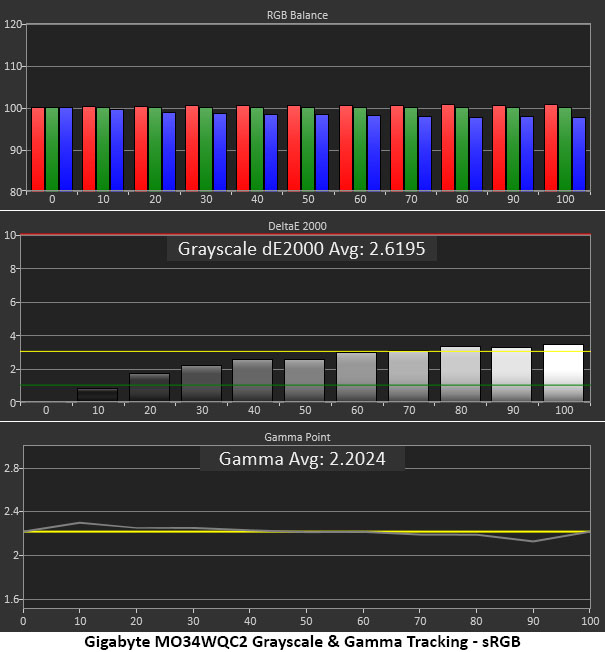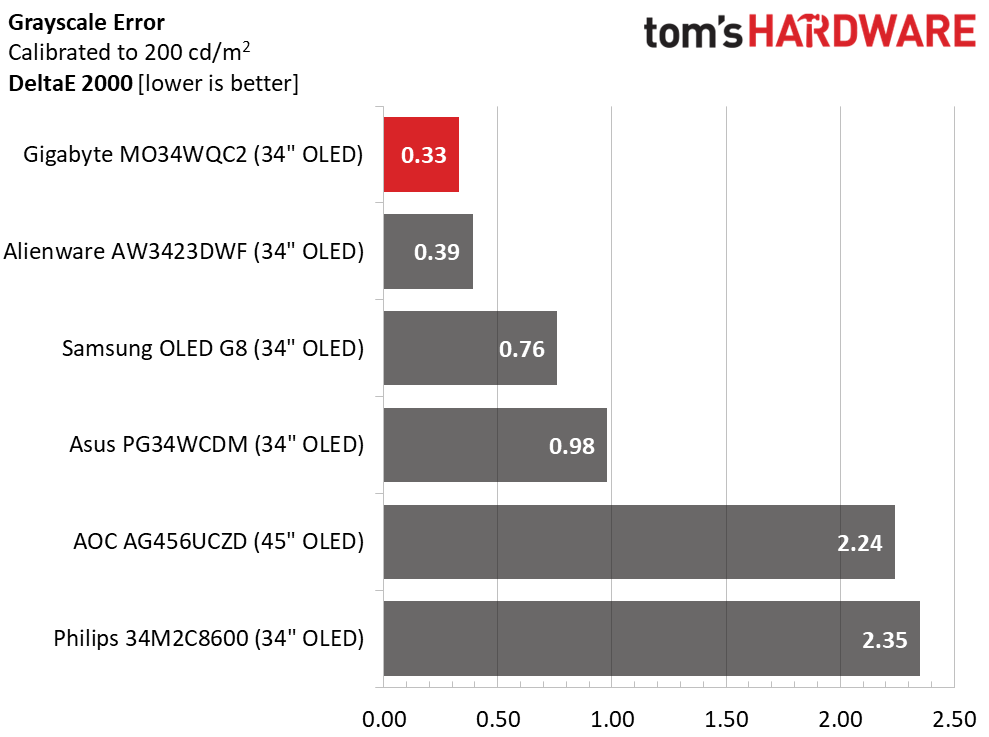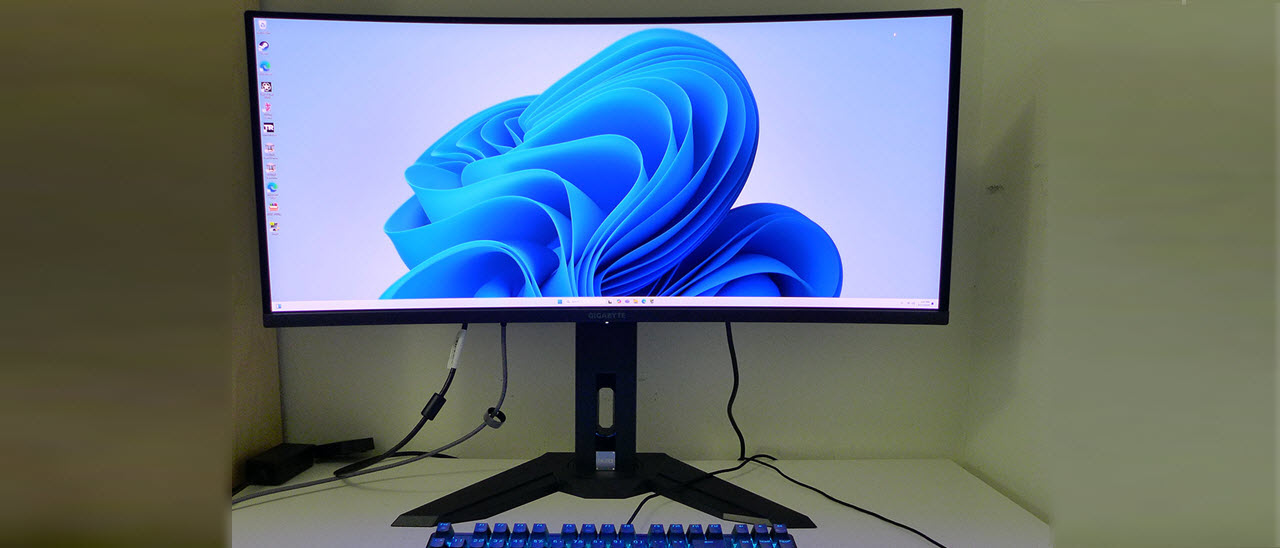Why you can trust Tom's Hardware
The MO34WQC2 is exceptionally accurate out of the box with no need for calibration in its Standard picture mode. The native color gamut is very large but there is a usable and equally accurate sRGB option.
Grayscale and Gamma Tracking
Our grayscale and gamma tests use Calman calibration software from Portrait Displays. We describe our grayscale and gamma tests in detail here.



Out-of-box grayscale charts don’t get much better than this. The MO34WQC2 has no errors over 1dE except for 90% brightness, which just cracks the line. There are no visible errors here. Gamma runs a shade dark, but since tracking is linear, you won’t see a problem. And it’s further mitigated by high contrast. You can set gamma to 2.0 if you want a lighter look, but I found this to be a little washed out for my taste. Calibration makes a tiny improvement in grayscale tracking but I’ve introduced a little peak at 90% that removes a little impact from bright highlights. You can solve this by using the default Normal color temp.
The sRGB mode has some warmth that’s barely visible at 80-100% brightness. It will be hard to find an issue with actual content. Gamma is almost perfectly in sync with the 2.2 reference, just showing slight aberrations at 10 and 90%. The MO34WQC2’s sRGB mode is completely qualified for critical applications and has adjustable brightness which is a nice bonus.
Comparisons




None of the screens need calibration, but the MO34WQC2 is one of the better examples of out-of-box accuracy I’ve tested. Going from 0.87 to 0.33dE is an invisible change so adjustment is only a matter of preference rather than a necessity. Gamma runs slightly dark with a 4.55% deviation from 2.2, but tracking is tight within a 0.17 range of values, so there is no negative impact there. And if you want lighter gamma, it’s a few clicks away with the OSD joystick.
Color Gamut Accuracy
Our color gamut and volume testing use Portrait Displays’ Calman software. For details on our color gamut testing and volume calculations, click here.



The MO34WQC2’s color gamut is very large with bonus hues on all sides of the CIE triangle. Red is the most oversaturated from the DCI-P3 reference and that’s something you can see in content, especially in SDR material. The target points are linear in progression, so clarity is maintained in all parts of the image. Hue errors are small enough to remain invisible. Out-of-box color doesn’t get much better than this.
Get Tom's Hardware's best news and in-depth reviews, straight to your inbox.
Calibration has no visual impact. There is a slight improvement in the numbers, with secondary colors now closer to their hue targets. But this is extreme nit-picking. In the sRGB test, you can see slight over-saturation in the red primary, but again, there is nothing to take the MO34WQC2 out of contention for professional applications. It is extremely accurate in all respects.
Comparisons


The MO34WQC2 has some impressive color gamut test results, but that is the norm for premium OLEDs. All the screens here measure below 2dE which is well below the visible threshold of 3dE. Given the cost, that is as it should be. But it’s good to know that you pretty much can’t buy a bad OLED. This is excellent performance.
You can see the effect of the Quantum Dot layer in the first four screens. The MO34WQC2 sits atop the pack with over 110% coverage of DCI-P3. Only a handful of screens have more color than this. You’ll be hard-pressed to see a difference in the top four, but you will definitely notice more saturation than the AOC and Asus monitors. Reds are especially vibrant but green and blue are nearly as vivid. sRGB is a bit over 107% thanks to some bonus red. Since its total error is just 1.82dE, it’s fully qualified for color-critical applications.
Test Takeaway: I have yet to find an OLED gaming monitor that strays too far from color standards, but the MO34WQC2 is one of the better examples. It doesn’t need calibration and it has one of the largest gamuts you’ll find in any monitor. Its sRGB mode is near reference-level which sets it apart from others. When it comes to image fidelity, it can’t get much better than this.
MORE: Best Gaming Monitors
MORE: How We Test PC Monitors
MORE: How to Buy a PC Monitor
MORE: How to Choose the Best HDR Monitor
Current page: Grayscale, Gamma and Color
Prev Page Brightness and Contrast Next Page HDR Performance
Christian Eberle is a Contributing Editor for Tom's Hardware US. He's a veteran reviewer of A/V equipment, specializing in monitors. Christian began his obsession with tech when he built his first PC in 1991, a 286 running DOS 3.0 at a blazing 12MHz. In 2006, he undertook training from the Imaging Science Foundation in video calibration and testing and thus started a passion for precise imaging that persists to this day. He is also a professional musician with a degree from the New England Conservatory as a classical bassoonist which he used to good effect as a performer with the West Point Army Band from 1987 to 2013. He enjoys watching movies and listening to high-end audio in his custom-built home theater and can be seen riding trails near his home on a race-ready ICE VTX recumbent trike. Christian enjoys the endless summer in Florida where he lives with his wife and Chihuahua and plays with orchestras around the state.
